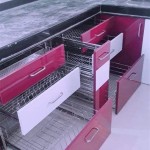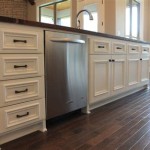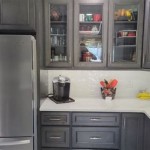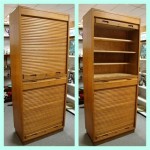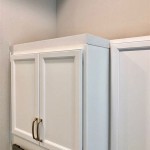How to Clean High Gloss Kitchen Units: A Comprehensive Guide
High gloss kitchen units offer a sleek, modern aesthetic, reflecting light and enhancing the overall brightness of the kitchen. However, their reflective surface also readily reveals fingerprints, smudges, and general kitchen grime. Maintaining the pristine appearance of these units requires a specific cleaning approach that prioritizes gentle cleaning solutions and techniques. This article provides a detailed guide on how to effectively and safely clean high gloss kitchen units, ensuring their longevity and continued shine.
The primary concern when cleaning high gloss surfaces is avoiding scratches. Harsh abrasive cleaners, scouring pads, and overly aggressive scrubbing can permanently damage the surface, dulling the finish and creating an unsightly appearance. Therefore, the emphasis must be on preventing damage while thoroughly removing dirt and grease.
Prepare for Cleaning: Gathering Essential Supplies
Before commencing the cleaning process, it is crucial to gather the necessary supplies. This preparation ensures efficiency and minimizes the risk of using inappropriate cleaning tools. The following items are essential:
*Two Microfiber Cloths:
Microfiber cloths are ideal for cleaning high gloss surfaces due to their non-abrasive nature. They effectively lift dirt and grime without scratching the delicate finish. It's best to have two – one for washing and one for drying. *Warm Water:
Warm water is a fundamental cleaning agent, capable of dissolving many types of kitchen grease and dirt. *Mild Dish Soap:
A gentle dish soap, free from harsh chemicals and abrasives, is essential for cutting through grease and grime. Opt for a pH-neutral formula. *White Vinegar (Optional):
White vinegar is a natural cleaning agent that can help remove stubborn stains and grease. However, its use should be limited and diluted appropriately. *Spray Bottle (Optional):
A spray bottle can be helpful for applying the cleaning solution evenly over the surface of the high gloss units. *Soft Sponge (Optional):
A soft sponge can be used, but make sure it is non-abrasive and only use it for areas that need a bit more cleaning. *Bucket or Bowl:
To hold the warm water and cleaning solution.Avoid using abrasive cleaners, scouring pads, steel wool, or any cleaning products containing bleach or ammonia, as these can damage the high gloss finish. Always test any new cleaning solution on an inconspicuous area of the unit before applying it to the entire surface.
The Cleaning Process: Step-by-Step Instructions
The cleaning process involves a systematic approach to ensure thoroughness and prevent damage. Follow these steps for optimal results:
-
Dusting:
Begin by removing loose dust and debris from the surface of the high gloss units. Use a dry microfiber cloth to gently wipe down the surface. This preliminary step prevents scratching during the subsequent cleaning stages. -
Preparing the Cleaning Solution:
Fill a bucket or bowl with warm water. Add a small amount of mild dish soap (approximately one teaspoon per gallon of water). Stir gently to ensure the soap is evenly distributed. If using white vinegar, add a tablespoon to the same amount of war water. Overuse might damage the surface. -
Washing the Units:
Dampen one of the microfiber cloths with the cleaning solution. Wring out the cloth to avoid oversaturation. Gently wipe down the surface of the high gloss units, starting from the top and working your way down. Use a circular motion to lift dirt and grime. If you are using a sponge, wring as much water as you can, so that surface is not over-exposed to water. -
Removing Stubborn Stains:
For stubborn stains, such as grease splatters, allow the cleaning solution to sit on the affected area for a few minutes before wiping it away. Avoid excessive scrubbing, as this can damage the finish. If necessary, repeat the process. -
Rinsing (If Necessary):
After washing the units, some cleaning solutions might leave a slight residue. If this occurs, dampen a clean microfiber cloth with fresh warm water and gently wipe down the surface to remove the residue. -
Drying:
Immediately dry the surface with the second clean, dry microfiber cloth. This step is crucial to prevent water spots and streaks, which can detract from the high gloss finish. Buff the surface gently to restore its shine.
Pay particular attention to areas around handles and edges, as these tend to accumulate more dirt and grime. Regularly replace the cleaning solution as it becomes dirty. Using dirty water can redeposit grime onto the surface, negating the cleaning efforts.
Maintaining the Shine: Preventative Measures and Regular Cleaning
Regular cleaning is essential for maintaining the shine of high gloss kitchen units and preventing the buildup of stubborn stains. Implementing preventative measures can further minimize the need for frequent cleaning.
*Wipe Up Spills Immediately:
Promptly wipe up spills and splatters with a damp cloth to prevent them from drying and becoming more difficult to remove. *Use Splashbacks:
Install splashbacks behind cooktops and sinks to protect the units from grease and water splashes. *Ventilation:
Ensure adequate ventilation in the kitchen to reduce the buildup of moisture and grease. Use the extractor fan when cooking. *Avoid Direct Contact with Heat:
Prevent direct contact with hot pots and pans, as this can damage the high gloss finish. *Regular Dusting:
Dust the units regularly to prevent the accumulation of dust and debris. *Weekly Cleaning:
Clean the high gloss units at least once a week to maintain their shine and prevent the buildup of grime.By following these preventative measures and maintaining a regular cleaning schedule, you can significantly prolong the lifespan and appearance of your high gloss kitchen units.
Choosing the right type of cleaner is crucial. While some commercial cleaners advertise themselves as suitable for high gloss surfaces, it is always advisable to test them on an inconspicuous area first. Many people prefer to stick to the simple and safe solution of warm water and mild dish soap. Additionally, avoid using excessive amounts of water. High gloss materials are often applied to MDF or particleboard, which can swell if exposed to excessive moisture. Always wring out cloths and sponges thoroughly before applying them to the surface.
If you are struggling with particularly stubborn stains or have accidentally scratched the surface, it may be worth consulting a professional cleaning service or a kitchen renovation specialist. They may have specialized cleaning products and techniques that can help restore the appearance of your units. However, in many cases, regular and careful cleaning, as described above, will be enough to keep your high gloss kitchen units looking their best for years to come.
Furthermore, be mindful of the environment in which your kitchen is located. If your kitchen is in a high-traffic area or is exposed to direct sunlight, you may need to clean your high gloss units more frequently. Direct sunlight can cause the finish to fade or yellow over time, so it is important to take steps to protect your units from excessive exposure.

How To Clean Gloss Kitchen Doors Blog Warehouse

How To Clean High Gloss Kitchen Units

How To Clean High Gloss Kitchen Units Properly

How To Clean High Gloss Kitchen Units Properly

How To Clean High Gloss Kitchen Units Properly

Cleaning Mrs Hinch Fans Share Best Tips To Spruce Up Kitchen Cupboards Express Co

The Best Way To Clean A High Gloss Surface

How To Clean High Gloss Kitchen Units Properly

How To Clean High Gloss Kitchen Units The Organizer

How To Clean Your Gloss Kitchen Cabinets Unica Concept
Related Posts

